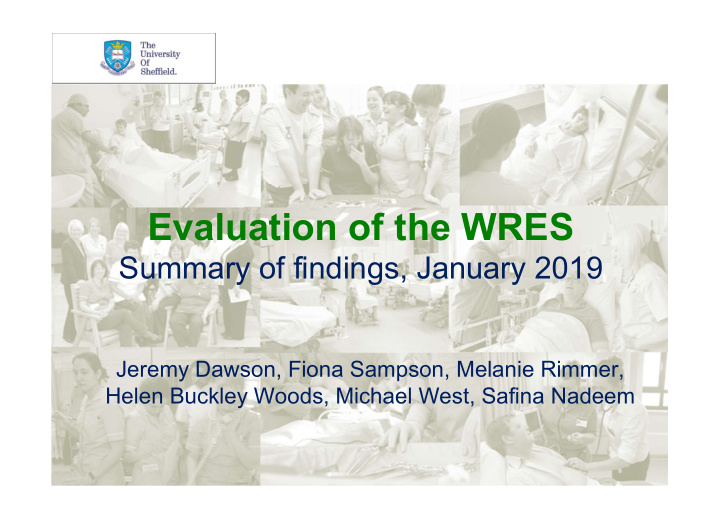



Evaluation of the WRES Summary of findings, January 2019 Jeremy Dawson, Fiona Sampson, Melanie Rimmer, Helen Buckley Woods, Michael West, Safina Nadeem
Evaluation Questions (1) 1. What were the reasons for the introduction of the WRES? 2. How successful has the implementation of the WRES been (e.g. clarity of documentation, clarity of purpose, clarity of reporting, adherence by trusts to requirements)? 3. To what extent is the WRES accepted as a valid and reliable measure by relevant staff in NHS trusts? 4. How accurate and reliable is the data that trusts provide in relation to the dimensions assessed in the WRES?
Evaluation Questions (2) 5. Which trusts are doing least well in relation to levels of discrimination and climates of inclusion and what might be the reasons for their poor performance? 6. To what extent is change occurring across the NHS as a whole, following the introduction of the WRES? 7. To what extent has the WRES been responsible for that change? 8. Are there case studies within the NHS or elsewhere that can help guide improvement on workforce race equality within the NHS?
Methods • Telephone interviews with 12 senior stakeholders • Telephone interviews with WRES leads in 15 trusts Analysis of meeting minutes and other official publications • 5 brief case studies (telephone interviews + focus group) • Rapid literature review on interventions to reduce inequality between racial groups in the workforce • Quantitative analysis of WRES data alongside other NHS data
Introduction/Implementation • WRES generally viewed positively • Impossible to ignore at senior levels • Less awareness at more junior levels however • Support by implementation team extremely positive • Methods for data collection and reporting generally positive and improving
Acceptability of WRES • In most cases the rationale is well understood and accepted • Some question the focus on race at expense of other characteristics; more salient in some area of the country than others • Lack of differentiation between White British & other White staff problematic in some areas
Validity of WRES indicators • Many appreciate the focus on a few measurable indicators where the data (mostly) exists already • Some preferred more specific, objective indicators, feeling that the staff survey indicators are too difficult to change • Others thought that broader cultural indicators would be more important • Specific concerns over indicator 4 (training), and indicators 5 & 6 (bullying, harassment & abuse)
Changes in performance • Some evidence of improvements in multiple indicators • HOWEVER: • Less improvement in those measured by staff survey • Most improvement happens early in process; very little change in last year, and some decline (particularly indicator 6) • Overall, only indicators 2, 7 and 9 show statistically significant improvements across the whole period
Appointment from shortlisting Indicator 2 2.50 2.00 1.50 1.00 0.50 0.00 2016 2017 2018 Acute MH/LD Community Ambulance
Experience of discrimination Indicator 7 2.50 2.00 1.50 1.00 0.50 0.00 2015 2016 2017 2018 Acute MH/LD Community Ambulance
White membership of boards Indicator 9 96% 94% 92% 90% 88% 86% 84% 82% 80% 78% 2016 2017 2018 Acute MH/LD Community Ambulance
WRES as a catalyst for change • Process of data collection and reflection on its own has opened the eyes of many on trust boards (but not unanimously) • Some changes to recruitment processes, including at board level, and relevant training • Creation of support networks & celebratory events • Increase in capacity for dealing with BME & other diversity/inclusion issues when they arise • Case study evidence mixed
Case Studies Community Mental Health Trust Large Acute Ambulance Trust Trust Acute Arms-Length Specialist Body Trust
Conclusions • Early signs of improvements are encouraging but not unanimous • Needs to continue with same commitment & momentum! • It is vital to retain the same indicators and methodology so trusts can learn as much as possible from their data • Leadership of the WRES at national and local levels needs to be a key focus • “Monitoring fatigue” needs keeping to a minimum by greater use of existing data and procedures. Embedding within system has started well but needs maintaining
Continuing evaluation • Evaluation of experts programme • Quantitative analysis – comparing composite indicators with other NHS data
Recommend
More recommend